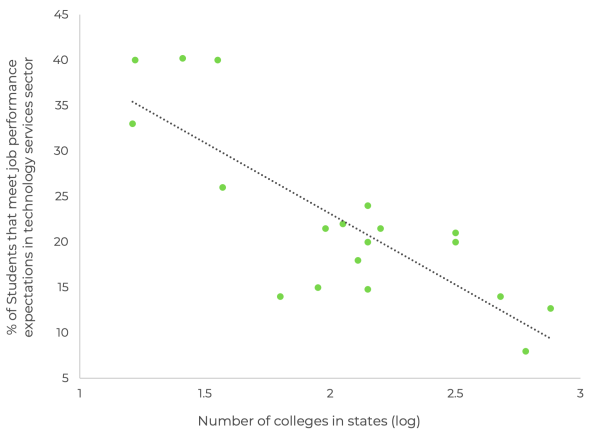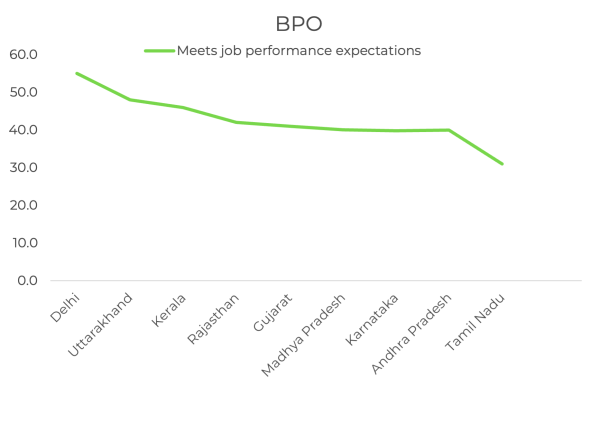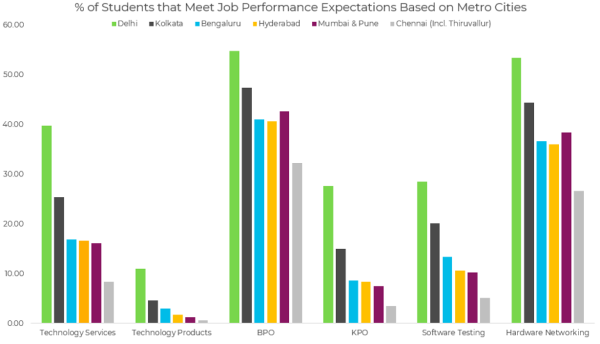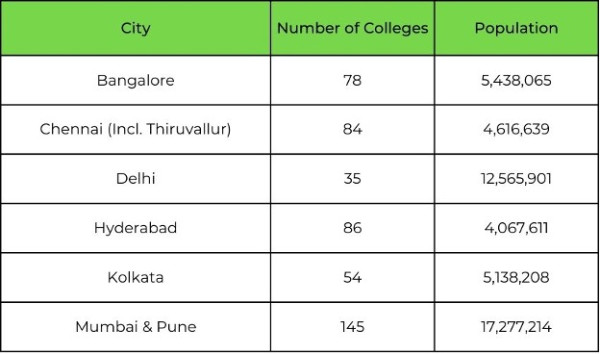Software Engineering Graduates in India: How Does Job Performance Stack up by State?
In this blog, we studied the job performance of software engineering graduates in India and stack ranked states based on “employability quotient.
Share
India is a diverse country, and the Diversity extends to the software engineering graduates across the states. Technical education in India has scaled over the last decade boasting thousands of software engineering colleges spread across the length and breadth of the country producing over half a million software engineering graduates annually. However, quantity does not always translate to quality. In fact, in SHL’s National Employability Report, we found that for the past decade, the quality of software engineers in India has not changed on aggregate level.
Companies around the globe, either those in India that focus on early careers hiring or those outside of India that want to build teams in India, want to meet their hiring goals quickly and confidently. The need for a balance between quantity and quality sparked questions across industries. How many of those software engineering graduates can produce logically correct code and possess technical competence? In India, topics such as “employability of software engineering graduates” pop up. This term “employability” indicates the percentage of software engineering graduates who can truly meet the job performance expectations.
For that reason, SHL Technology Hiring’s research team explored the sectoral job performance of software engineering graduates, with 120,000 software engineers from every state in India in 2019. We found that some states focus on numbers and not quality, and vice versa. Our research team has done advanced statistical studies to uncover the core reasons for the dramatic variation in the quality of talent being produced, plus the percentage of candidates who meet the job performance expectations, state by state, in Technology Services, Technology Products, and Business Process Outsourcing (BPO) firms in India.
This study revealed four main takeaways:
- Overall, Delhi has the highest percentage of engineers who meet job performance expectations across all the industries (technology services and products, BPO, KPO, software testing, and hardware networking), despite having the lowest numbers of software engineering colleges than other major metropolitan cities in the country.
- Echoing the point above, in general, the more software engineering colleges there are in the state, the less likely they produce high-quality software engineers, even though this depends on socio-economic and developmental factors. But this clearly means that the states need to focus on improving education in the existing colleges, rather than adding more colleges.
- Delhi has emerged as the best education hub with high standards of education in the country, and this is especially true for English and cognitive skills which are vital to technology services, while Uttar Pradesh is the software engineering hub that produce graduates with the highest percentage of meeting the job performance expectations.
- As understanding programming language and algorithm are more important for companies developing technology product, education quality becomes crucial. The highest percentage of software engineering graduates who meet job performance expectations in technology product is in Bihar-Jharkhand, followed by Gujarat and Kerala as the top three.
It is observed that job performance in technology services companies is highest in North, followed by East, then West and then South. Delhi and Bihar-Jharkhand emerge as states with the largest percentage of software developers who meet job performance expectations. Delhi, with its select colleges, has emerged as an education hub with high standards of education and attracting the best minds from across the country (see Figure 1).
In India, there is also a concentration of software engineering colleges in a few states. The report looked at the ranking of states considered as ‘software engineering hubs’ by employability in the technology services sector. It is observed that states with more government colleges as compared to private colleges fare better on job performance. Here is the job performance rank in terms of software engineering hubs:
- Uttar Pradesh
- Karnataka
- Maharashtra
- Andhra Pradesh
- Tamil Nadu
The impact of number of colleges on quality of education
As we see above, there are variations in the percentage of meeting job performance expectations across states. Our research team looked into establishing the factors which could explain the dramatic variations in the numbers across states. They considered the impact of the state population, size of the state, number of colleges, gender spread, etc. as a possible explanation.
We hypothesize that just the sheer number of software engineering colleges in a state influences the percentage of student meeting job performance expectations in the state. Wherein the number of software engineering schools are lower in number, the employability is higher and vice-versa. To check this hypothesis, we analyzed the relationship between the percentage that meet job performance expectations and the number of software engineering colleges in each state.

Figure 2: The percentage of meeting job performance expectations correlated to the number of software engineering colleges in each state
Interestingly a very high correlation (of -0.834) was found between the percentage of software engineers suitable for recruitment in technology services and the number of colleges in the state. This means that their suitability for a job falls with the increase in the number of colleges in the state. Interestingly, the result is not improved by adjusting the count by population or size of the state. Probably, other variables such as literacy levels, status of education, per capita income, etc. may be useful to get further insight. The result shows that adding more software engineering colleges in the state led to a fall in the percent of high-quality software engineers, which means the less likely they are to meet job performance expectations. A scatter plot is shown in Figure 2.
What do the results above imply?
The percentage of engineers that meet job performance expectations decreases with an increase in the number of software engineering colleges in a particular state, clearly establishing that opening more software engineering colleges shall not solve the problem of the quality of software engineers in the country. It is required that rather than opening more software engineering colleges, the state needs to concentrate on improving the education standards of current software engineering colleges.
Secondly, even though the number of colleges is a major factor in guiding job performance in a particular state, it does not explain it completely. For instance, even though Tamil Nadu has a lower number of software engineering colleges (~600) as compared to Andhra Pradesh (~750), it has a lower job performance percentage (8.33 as compared to 12.73). Similarly, Delhi has more colleges than Bihar, but higher employability. In a nutshell, Tamil Nadu, Andhra Pradesh lag behind in the average quality of talent while in metros, Delhi again has the best software engineers followed by Kolkata and Bangalore.
The percentage of meeting job performance expectations for a state is a complex interplay due to several socio-economic and developmental factors. What is required is a greater focus on improving the quality of software engineering education.
Companies developing technology products
Figure 3: Job performance in technology product companies across states & UTs
With respect to technology product companies (See Figure 3), it may be noted that the trends are different. Whereas technology services’ employability is mainly a function of English and cognitive skills, the skills in coding and algorithms also become necessary for technology product companies. Because of this, the education in college has an equal, if not more impact on the job performance in technology product sector as compared to the impact of the quality of students when they join the college. This is also evident with the fact that the correlation to the log of the number of students falls to -0.72 from -0.83 in the case of technology services companies. The number of colleges is a suitable proxy for intake quality.
Three states, i.e. Uttarakhand, Kerala, and Chhattisgarh, show largely different ranks with respect to the percentage of meeting job performance expectations in technology services and technology product companies. Whereas Kerala and Chhattisgarh better their position in technology product, Uttarakhand climbs down. This is indicative of better education within colleges in Kerala and Chhattisgarh.
Business Process Outsourcing (BPO)

Figure 4: Job performance in KPO Companies across States & UTs

Table 1: Key Cities
We compared the percentage of meeting job performance expectations across colleges within major metros in the country (see Table 1). We found similar trends to those with regard to job performance in states. Delhi (north) shows the highest percentage followed by Kolkata (East), cities in the West, and the lowest figures were observed in colleges in Southern cities.
The skew in the percentage of meeting job performance expectations is quite high, for instance, the technology product job performance in Delhi is as high as 1 in every 9 candidates and as low as 1 in every 200 in Chennai. Even though Bengaluru has similar technology services’ job performance as compared to other Southern and Western cities, it shows much higher probability of meeting job performance expectations for technology product companies. This indicates that candidates in Bengaluru do much better at coding and algorithms even though they show similar English and cognitive skills. This could be better exposure to coding either at home, school, or college.
The reason for this skew is explained again by the trend in the number of colleges in each of these cities (See Table 2 below). The proliferation of software engineering colleges in South India and the West has brought down the percentage of meeting job performance expectations figures. There are way lesser software engineering colleges both in Delhi and Kolkata—this is in spite of the fact that the population of Delhi is much more than Southern cities and comparable to that of Mumbai.

Table 2: No. of Colleges in Metro Cities
Technology companies around the world want to meet their hiring goals with confidence, and that means hiring high-quality software engineers. With hundreds of thousands of software engineering graduates in India, the percentage of those graduates who meet the job performance expectations is not equal. Our study provided a guidance for hiring managers and leaders that want to build teams based in India. The “employability” of software engineering graduates in India based on the state is complex because of many socio-economic and developmental factors. What hiring managers need to focus on is finding the software engineers that have the technical competence and skills, not just those that are book-smart.
SHL Technology Hiring helps you select and hire the best software engineers objectively. Book a demo with one of our experts today!









